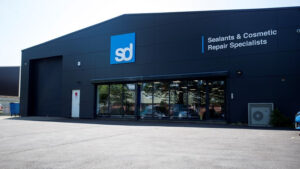Construction and building industries are under inscrutable pressure to find sustainable solutions, after it was revealed that the sector produced roughly 11.4 million metric tons of carbon dioxide emissions in 2020* from manufacturing, transport of materials and refurbishment projects.
As such, the UK has committed to reducing carbon emissions by 80% by the year 2050**, and projects that include refurbishment will have an important part to play in meeting this target.
Across the UK, industry leaders are constantly exploring new ways to become more sustainable to combat the climate crisis. But what can businesses do to make a difference? We’ve worked to help a number of decision makers and advisors embed sustainable development. Cosmetic repairs are a key to empowering our partners to meet industry environmental targets.
- Cosmetic repair solutions are more efficient and timely
Cosmetic repairs, used in many renovation and refurbishment projects, can be applied to an extensive list of surfaces to fix unsightly chips, scratches, and cracks to an exacting standard. Technicians tend to be required during the last stages of a construction project when contractors are under pressure to meet deadlines, and the risk of accidental damage to surfaces, such as walls or doors increases. Choosing cosmetic repair instead of replacing an item won’t delay any tight deadlines, as there will be no need to wait for delivery times or new products to come into stock. A cosmetic technician is available promptly for any project, big or small.
- It can reduce your environmental impact
Cosmetic repair helps a business demonstrate its commitment to the environment by repairing damaged items rather than replacing them, which means less waste.
The construction industry alone is responsible for five million tonnes of demolition waste*** that finds its way to landfills, making cosmetic repair a more sustainable solution than throwing things away. Overall, the cosmetic repair is a slick, quick and accurate remedy to reducing such waste, while also making your damaged items look brand new. This is achieved by professional technicians having the skills and tools required to repair damaged surfaces rather than stripping them out and replacing them.
Utilising a repair technician, rather than replacing items or whole rooms, also significantly reducing the carbon footprint of a project. A bathroom replacement due to a damaged bath, for instance, could entail a plumber, a tiler, a floor fitter and builder. All in separate vehicles and making multiple journeys. A single repair technician to repair the damaged bath would make a single trip and the end result – a perfectly functional bathroom – is the same.
Beyond this, industries should also consider the processes required to build replacement items. Such resources as energy, materials and transportation are needed during manufacturing processes, resulting in more carbon being emitted into the environment. While some items and parts can be recycled, they still require a standard amount of energy, meaning that repair and restoration are better for the environment and businesses can show that they have moved on from a disposable to sustainable mode of operation.
- You’ll be reducing your overall project cost
We all want to make greener choices in life and business, but generally only if it doesn’t hurt the bottom line too much. Not only will businesses save on replacing broken or damaged fittings, but they will also reduce disruption to the project and potential delays on top of the cost of a new product. In addition, by refurbishing or tidying up damaged surfaces, businesses will pay less than buying an item brand new, especially if those items are antique, vintage or irreplaceable.
It may come as no surprise, but the most common types of cosmetic surface repairs in the housing sector tend to be the repair and restoration of worktops, sanitaryware and kitchen units. These are expensive to remove, replace and are unable to be recycled so inevitably contribute to the previously mentioned waste levels, so by expertly restoring the original look of an item, you will be saving the need for replacement.
Knowing whether to repair or replace isn’t often straightforward, but it’s important to remember that even the most heavily damaged items can be restored to their original state, no matter their age. In these times of rising costs and tight budgets, focusing on repairing rather than replacing items is not only kinder to the environment but it is beneficial to the bottom line.








